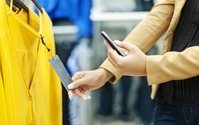Beacons: Getting Beyond The Buzz
- by Mark Walsh @markfwal, March 13, 2014
 Beacons, especially Apple’s iBeacon, are this year’s It Girl when it comes to retail technology. The Bluetooth low-energy (BLE)-based system that lets smartphones interact
with sensors placed in physical locations is generating ample buzz and blue-sky predictions about how it can drive in-store sales from mobile-addicted shoppers.
Beacons, especially Apple’s iBeacon, are this year’s It Girl when it comes to retail technology. The Bluetooth low-energy (BLE)-based system that lets smartphones interact
with sensors placed in physical locations is generating ample buzz and blue-sky predictions about how it can drive in-store sales from mobile-addicted shoppers.
But a new Forrester report suggests the hype obscures the effort required to maintain a beacon platform in-store, as well as the full benefits it could bring to businesses and consumers. That’s not surprising, considering that the rollout of the technology is still at an early stage.
The research firm estimates about 30% of U.S. smartphones are currently enabled to connect to beacons using BLE. That includes devices running Android 4.3 or later and iPhone models since the release of the iPhone 4S. That figure is expected to grow to 80% in the next 18 months as people upgrade phones.
For retailers, setting up a beacon system is not as simple as slapping a few low-cost transmitters around a store and letting customers start ringing up sales on their handsets. First, shoppers need to have Bluetooth switched on in their phones for it to work.
Second, a shopper must have an app installed and running that can interact with the BLE hardware within the device. The upside is that this shows who in the store is interacting with beacon so a retailer can provide more personalized service. The drawback of targeting only those who have installed a retailer’s branded app is that it’s too small a pool of customers to make much difference.
To use beacons effectively, they must also be linked to a campaign management system to trigger relevant content and offers, a robust WiFi or LTE connection to help deliver that content and a platform to manage what might be thousands of beacons for a national retailer.
Plus, dedicated staff is needed to set up and maintain beacon campaigns along with adequate security infrastructure to prevent “spoofing,” or the emulation of a beacon signal to show a competitor’s ad. Apple’s iBeacon protocol, for instance, doesn’t inherently provide security or encryption since it’s designed to be an open standard.
The report points out that some third parties are building beacon technology into existing offerings to ease retailer adoption. Shopkick, for example, has rolled out beacons at Macy’s and American Eagle to boost usage of its shopping app. Similarly, InMarket is putting beacons in over 200 grocery stores, allowing them to interact with its apps such as List Ease and CheckPoints.
While results so far are limited, the study authored by Forrester analyst Adam Silverman, indicates that early beacon efforts show promise. InMarket, for instance, said in-store beacon ads have much higher CPM rates than mobile banner ads.
Separately, beacon technology provider Swirl noted that its pilots with major retailers yielded 75% open rates and 35% redemption rates for mobile offers. Of course, it will be more valuable over time to get feedback from retailers and brands on the effectiveness of beacons.
Silverman advises companies to resist the urge to “jump on the beacon bandwagon” for
its own sake, but to enhance the customer experience. The report emphasizes beacons can be used for more than just sending notifications and offers. That includes alerting associates to assist
customers and providing in-store mapping.
"Mobile Shopping" photo from Shutterstock.















